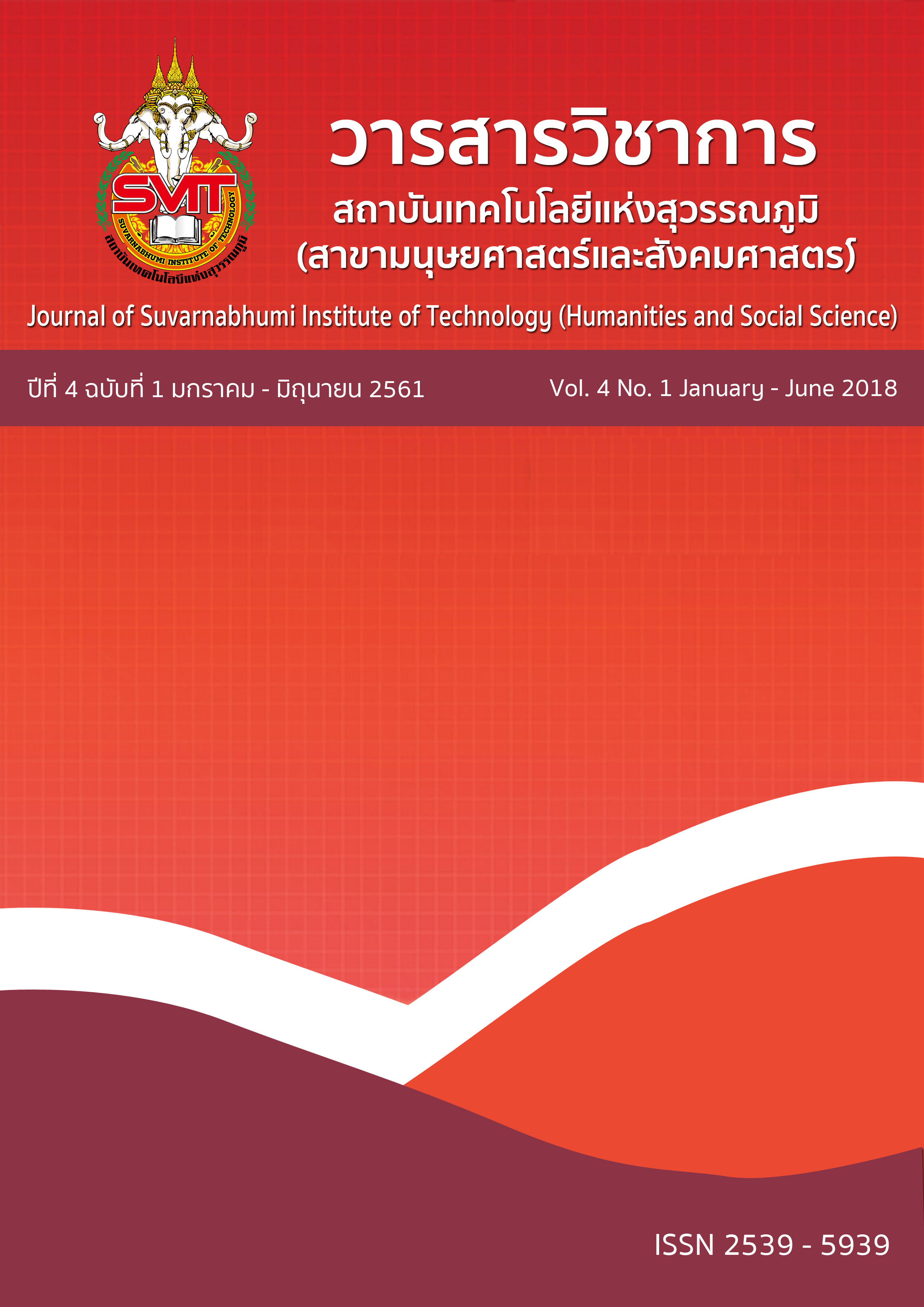THE RELATIONSHIP BETWEEN POWER OF MANAGEMENT WITH ORGANIZATION COMMITMENT IN FACTORIES INDUSTRIAL ESTATES NAVANAKORN, NAKORRATCHASIMA PROVINCE
Keywords:
Organization Commitment, Power of Management, The RelationshipAbstract
This research aims to study (1) the level of opinion on the use of executive power. Organizational commitment. (2) The relationship between the use of power in organizational commitment management. The sample was used in the research. The samples were randomly sampled using a questionnaire as a tool to collect data and interviews. Then, they were processed using a software program to evaluate the opinions on the use of the power of the executives, the Organizational Commitment. The mean (Mean) of the standard (S.D.) and the relationship between the use of executive power Organization Relationships Pearson's Correlation Coefficient (Pearson's Correlation Coefficient)
The research found that:
1. Opinions on the use of administrative power. Overall, the level of executive power has low levels of power. On the other hand, it is found that the use of legal power. The weight of opinion was first, followed by the use of reference power. Use of expertise. Use the power to reward. In general, the opinions on the organization in the three aspects of decision making are low. When considering each aspect, it was found that organizational commitment towards attitudes toward the organization. The first is the weight of opinion, the second is the continuous operation and the performance according to social norms.
2. The Relationship of management power testing result: Using the power of the Executive, the legal authority, the use of the reference, using the power of expertise, using the power of rewards and using the threat of force has relationship with commitment to the organization in the attitude towards the organization, continue to provide operational continuity and operational norms of the society at the level of significance .05
References
จุมพล หนิมพานิช. (2543). ผู้นำ อำนาจ และกำรเมืองในองค์กำร. นนทบุรี: มหาวิทยาลัยสุโขทัยธรรมาธิราช
จักรพันธ์ ชูกลิ่น. (2557). ควำมสัมพันธ์ระหว่างภาวะผู้นำและการใช้อำนาจของผู้บริหารสถานศึกษำ สังกัดสำนักงานเขตพื้นที่การศึกษาประถมศึกษา กระบี่. (วิทยานิพนธ์หลักสูตรศึกษาศาสตรมหาบัณฑิต สาขาบริหารการศึกษา, มหาวิทยาลัยบูรพา ชลบุรี).
ชวัลณัฐ เหล่าพูนพัฒน์. (2548). ปัจจัยส่งผลต่อความผูกพันกับองค์การ โดยมีความพึงพอใจในงานเป็นตัวแปรสื่อ. (วิทยานิพนธ์ปริญญาศิลปศาสตรมหาบัณฑิต สาขาวิชาจิตวิทยาอุตสาหกรรมและองค์การ บัณฑิตวิทยาลัย, มหาวิทยาลัยธรรมศาสตร์).
ธีระ รุญเจริญ. (2550). ความเป็นมืออาชีพในการจัดและบริหารการศึกษายุคปฏิรูปการศึกษา. กรุงเทพมหานคร : แอล. ที. เพรส จากัด.
ปาริชาต บัวเป็ง. (2554). ปัจจัยที่มีต่อความผูกพันต่อองค์กรของพนักงาน บริษัท ไดกิ้นอินดัสทรีส์ ประเทศไทย จำกัด. (การค้นคว้าอิสระหลักสูตรบริหารธุรกิจมหาบัณฑิต, คณะบริหารธุรกิจ มหาวิทยาลัยเทคโนโลยีราชมงคลธัญบุรี ปทุมธานี).
ษมาพร ปลื้มจิตร. (2557). ความผูกพันต่อองค์กรของพนักงำนโรงแรมดุสิตแกนรีสอร์ทแอนด์โปโลคลับ. (วิทยานิพนธ์ปริญญาศิลปศาสตรมหาบัณฑิต สาขาวิชารัฐศาสตร์ บัณฑิตวิทยาลัย, มหาวิทยาลัย เกษตรศาสตร์).
สมยศ นาวีการ. (2540). กำรบริหารและพฤติกรรมองค์กำร. กรุงเทพมหานคร: ผู้จัดการ.
สำนักงานคณะกรรมการพัฒนาการเศรษฐกิจและสังคมแห่งชาติ. (2559) แผนพัฒนาเศรษฐกิจและสังคมแห่งชาติฉบับที่ 12 สานักนายกรัฐมนตรี กรุงเทพมหานคร.
อาคม วัดไธสง. (2547). หน้าที่ผู้นำในการบริหารการศึกษา. พิมพครั้งที่2. สงขลา: ภารกิจเอกสารและตารามหาวิทยาลัยทักษิณ.
อาพร นิติสิริ. (2553). สถานการณ์แรงงานประจำสัปดาห์ 28 มี.ค - 3 เม.ย. 2553 อ้างใน https://prachatai.com/journal/2010/04/28713
Allen N J and Meyer J P. (1990). “The Measurement and Antecedents of Affective, Continuance and Normative Commitment to the Organization”, Journal of Occupational Psychology, Vol. 63, pp. 1-18.
Barnard, C.I. (1972). The Function of the Executive. Cambridge: Harvard University Press,
French,J.R.P.and B.H.Raven. (1968). Bases of Social Power”.pp.259-270. Group Dvnamics:Research and Theory. Darwin Cartwright and Alvin Zander. (ed.). New York:Harper & Row.
Lynn McFarlane Shore · Harry J. Martin Job. (1989). Satisfaction and Organizational Commitment in Relation to Work Performance and Turnover Intentions, Cororado state University. USA.
Richard T. Mowday, Lyman W. (1982). Employee-Organization Linkages: The Psychology of Commitment, Absenteeism, and Turnover. New York academic Press.
Rosabeth M. Kanter. (1972). Commitment and Social Organization: A Study of Commitment Mechanisms in Utopian Communities by J. Rabow. Los Angeles: Goodyear.
Sheldon, M.E. (1971). Investments and involvements as mechanisms producing commitment to the organization. Administrative Science Quarterly, pp 16, 143-150,
Downloads
Published
Issue
Section
License
บทความที่ได้รับการตีพิมพ์เป็นลิขสิทธิ์ของวารสารวิชาการ สถาบันเทคโนโลยีแห่งสุวรรณภูมิ
ข้อความที่ปรากฏในบทความแต่ละเรื่องในวารสารวิชาการเล่มนี้เป็นความคิดเห็นส่วนตัวของผู้เขียนแต่ละท่านไม่เกี่ยวข้องกับสถาบันเทคโนโลยีแห่งสุวรรณภูมิ และคณาจารย์ท่านอื่นๆในสถาบันฯ แต่อย่างใด ความรับผิดชอบองค์ประกอบทั้งหมดของบทความแต่ละเรื่องเป็นของผู้เขียนแต่ละท่าน หากมีความผิดพลาดใดๆ ผู้เขียนแต่ละท่านจะรับผิดชอบบทความของตนเองแต่ผู้เดียว




